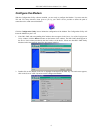
DSL-300G ADSL Ethernet Modem User’s Guide
1
Introduction
This section provides a brief description of the Modem, its associated technologies and a list of Modem features.
What is ADSL?
Asymmetric Digital Subscriber Line (ADSL) is an access technology that utilizes ordinary copper telephone
lines to enable broadband high-speed digital data transmission and interactive multimedia applications for
business and residential customers. For ADSL services, it is not necessary expensive new cabling or condition
the line in any way.
ADSL greatly increases the signal carrying capacity of copper telephone lines without interfering with regular
telephone services. For the ADSL user, this means faster downloads and more reliable connectivity. ADSL
devices make it possible to enjoy benefits such as high-speed Internet access without experiencing any loss of
quality or disruption of voice/fax telephone capabilities.
ADSL provides a dedicated service over a single telephone line operating at speeds of up to 8 Mbps downstream
and up to 640 Kbps upstream, depending on local telephone line conditions. A secure point-to-point connection
is established between the user and the central office of the service provider.
D-Link ADSL devices incorporate the recommendations of the ADSL Forum regarding framing, data format,
and upper layer protocols.
Modem Description and Operation
The DSL-300G ADSL Ethernet Modem is easy to install and use. You can use the Modem to connect any
computer with a functioning Ethernet interface.
Modem Features
The DSL-300G ADSL Ethernet Modem utilizes the latest ADSL enhancements to provide a reliable Internet
portal suitable for most small to medium sized offices. DSL-300G advantages include:
• Quick and easy installation with a user friendly GUI for configuration and management
• High data transfer rates; up to 8 Mbps downstream and up to 640 Kbps uspstream
• DSLAM interoperability; the auto-detect function automatically selects the correct connection type during
the initialization process
• MIB Support; built-in MIBs allow SNMP management functions
• Bridged Ethernet over ATM support; the DSL-300G supports RFC 2684 (also RFC 1483)
• Upgradable firmware using TFTP


















